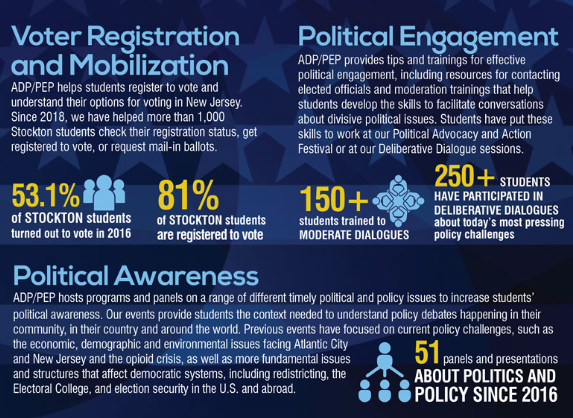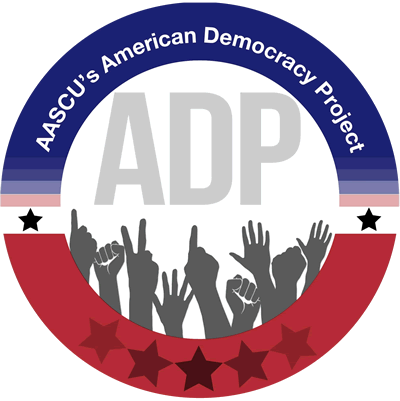Welcome
 The American Democracy Project (ADP) is an American Association for State Colleges
and Universities (AASCU) Program in which Stockton has participated since 2003. At Stockton, ADP is run by an interdisciplinary committee of faculty, staff, and students
who collaborate to plan and promote programming that fosters civic education. Throughout
the academic year, ADP develops programs on a range of different timely political
and policy issues that are designed to increase political awareness and engagement
for our campus community.
The American Democracy Project (ADP) is an American Association for State Colleges
and Universities (AASCU) Program in which Stockton has participated since 2003. At Stockton, ADP is run by an interdisciplinary committee of faculty, staff, and students
who collaborate to plan and promote programming that fosters civic education. Throughout
the academic year, ADP develops programs on a range of different timely political
and policy issues that are designed to increase political awareness and engagement
for our campus community.

Election Day is November 5, 2024
Check out our Voter Registration and Options for Voting in New Jersey pages for up-to-date information about how you can participate in this fall's general election.
Ways to Engage
What is going on in the state and federal government? What state and federal legislative districts do you live in, and who are your representatives? Learn the answers to these questions and how you can become engaged in state and federal elections.
Local Government
- Atlantic County
- Galloway Township
- Atlantic City
- Ocean County
- See something in your community that needs fixing, but not sure who to contact in your local government? Visit SeeClickFix!
New Jersey State Government and Politics
- State of New Jersey
- New Jersey Courts
- New Jersey Legislature
- State legislative districts
- Where and how to register to vote in New Jersey
Federal Government and Politics
We've compiled a guide on How to Organize in Politics where you'll find information about different ways to get involved in politics--through organized groups, through political parties, and through local governing boards.
Our guide on How to Contact Congress includes step-by-step information to make your contacts with your Representatives and Senators effective and impactful. Apply the same tips in your contacts with your elected officials at any level. This two-page handout on Contacting Congress offers a quick reference to help you reach to your members of Congress effectively.
Stockton offers a variety of civic, co-curricular, and academic engagement opportunities connected to the mission of ADP:
Not familiar with digital activism? Check out the short video on Harvard’s Internet & Democracy Project‘s site: “Introduction to Digital Activism.” You may also want to read the short article “Digital Activism on YouTube.”
Democracy
A Crucible Moment: An examination of students’ civic learning and democratic engagement in college study.
Environmental Issues
Groundwire: “Groundwire delivers technology to engage people, organizations and communities in building a sustainable society.”
Global Water Challenge: “Founded in 2006, the Global Water Challenge (GWC) is a coalition of leading organizations in the water and sanitation sector. Drawing upon the experience, expertise and assets of its 24 members, GWC is able to create partnerships that achieve far greater results than any one organization could achieve by itself.”
It’s Getting Hot in Here: “It’s Getting Hot in Here is the voice of a growing movement – a collection of voices from the student and youth leaders of the global movement to stop global warming. Originally created by youth leaders to allow youth to report from the International Climate Negotiations in Montreal in 2005, It’s Getting Hot in Here has since grown into a global online community with over 300 writers from countries around the world.”
Social Justice
Fahamu
Fahamu has a vision of the world where people organise to emancipate themselves from
all forms of oppression, recognise their social responsibilities, respect each other’s
differences, and realise their full potential
Ushahidi
Ushahidi, which means ‘testimony’ in Swahili, is a website that was initially developed
to map reports of violence in Kenya after the post-election fallout at the beginning
of 2008. Ushahidi’s roots are in the collaboration of Kenyan citizen journalists during
a time of crisis. The website was used to map incidents of violence and peace efforts
throughout the country based on reports submitted via the web and mobile phone. This
initial deployment of Ushahidi had 45,000 users in Kenya, and was the catalyst for
us realizing there was a need for a platform based on it, which could be use by others
around the world.
Mideast Youth
A student-owned independent network that promotes constructive dialogue and understanding
within the Middle East and North Africa. Arabs, Iranians, Kurds, and Israelis work
side by side on a variety of different projects in order to advance towards moderation
and interfaith understanding.
Feminist Digital Activism
Online Resources for Feminist Activism
A list compiled by the Stanford’s Women’s Community Center.
Activist Web Sites for Women’s Issues
Site created by Joan Korenman.
AWID
The Association for Women’s Rights in Development (AWID) is an international, multi-generational,
feminist, creative, future-orientated membership organization committed to achieving
gender equality, sustainable development and women’s human rights. A dynamic network
of women and men around the world, AWID members are researchers, academics, students,
educators, activists, business people, policy-makers, development practitioners, funders,
and more.
National Organization for Women
Free Speech Issues
Global Voices Advocacy: “Global Voices Advocacy is a project of Global Voices Online. We seek to build a global anti-censorship network of bloggers and online activists throughout the developing world that is dedicated to protecting freedom of expression and free access to information online.”
Track Your Activism
Splashlife: Take action and earn points. Points can be used for deals and discounts.
myImpact: Record, share and track your impact when you volunteer. Connect these activities with the greater good happening on the Stockton campus. Create your personal or group account and then add “eCitizenship-RSCNJ” as your organization. When you volunteer, serve as a mentor, or donate time or money, connect these activities to “eCitizenship-RSCNJ” and see the results add up.
Tools to Do Your Own Digital Activism
FrontlineSMS: “FrontlineSMS enables instantaneous two-way communication on a large scale. It’s
easy to implement, simple to operate, and best of all, the software is free. You just
pay for the messages you send in the normal way.”
DigiActive: “DigiActive is an all-volunteer organization dedicated to helping grassroots activists around the world use the Internet and mobile phones to increase their impact. Our goal is a world of activists made more powerful and more effective through the use of digital technology.”
MobileActive: “A global network of people using mobile technology for social impact.”
Our resources for safely protesting comes from the fall of 2020, when we hosted a conversation with Stockton student leaders on their experience organizing and facilitating protests focused on racial justice during. In this panel discussion, we discussed some tips for how to protest safely. Please check out these resources for additional helpful guidance:
Comments? Questions? Interested in joining the ADP Committee? Would you like to work with ADP?
Contact ADP Faculty Chair Claire Abernathy at claire.abernathy@stockton.edu



